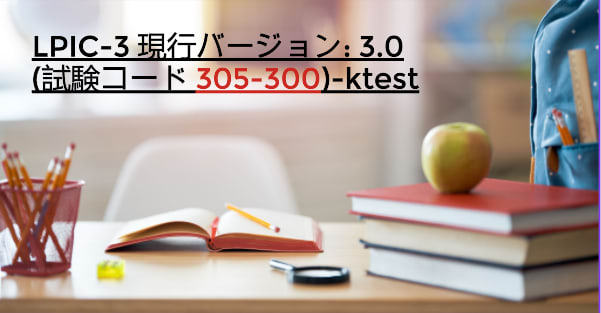LPIC-3 受験 は、Linux Professional Institute (LPI) が提供するマルチレベルのプロフェッショナル認定プログラムの集大成となる認定資格です。LPIC-3 305-300試験は、エンタープライズレベルの Linux プロフェッショナル向けに設計されており、業界内でも最高レベルのプロフェッショナルでディストリビューションに依存しない Linux 認定資格です。LPIC-3 には、4 種類の専門認定があります。4つの試験のいずれかに合格すると、その専門分野のLPIC-3認定を受けることができます。

LPIC-3 Virtualization and Containerization 認定資格は、仮想化とコンテナ化に重点を置き、企業全体の Linux システムの管理をカバーします。
現行バージョン: 3.0 (試験コード 305-300)
旧バージョン: 2.0(試験コード304-200) 英語版:2022年6月20日、日本語版:2022年10月31日まで受験可能です
試験範囲(Objectives): 305-300
受験資格: LPIC-3認定を受けるためには、アクティブなLPIC-2認定を取得している必要があります。
認定条件: 305の試験に合格すること。90分の試験は、60の多肢選択問題と穴埋め問題です。
有効期間: 5年
受験価格: お住まいの国の試験の価格については、こちらから確認してください。
VUEテストセンターで受験可能な試験の言語: 英語、日本語
OnVUEを利用してオンラインで受験できる言語: 英語、日本語
LPIC-3 仮想化とコンテナ化 認定を受けるには、LPIC-2 認定を取得し、305 試験に合格する必要があります。
LPIの試験内容はそれぞれのレベルや分野に合わせてよく考えられています。そしてLPIの試験の目的は、どのようなスキルが証明されるのか、またそのスキルの相対的重要性を示しています。 それゆえ、あなたが将来目指すことを見据えて、試験の内容・目的を参考に、学習計画を立てることが重要です。
LPIC-3 仮想化とコンテナ化 305-300 無料ダンプを共有します
1. Which of the following statements are true regarding IaaS computing instances? (Choose TWO correct answers.)
A. Creation of new instances can be automated by using scripts or APIs and service interfaces.
B. The root file system of a computing instance is always persistent and can be accessed after the instance is destroyed.
C. Each and every user of an IaaS cloud has exactly one computing instance.
D. Once created, computing instances are seldom deleted in order to ensure the accessibility of the instance's data.
E. Instances may be created when needed and destroyed when they become obsolete.
Answer: A, E
2. How can data be shared between several virtual machines running on the same Linux-based host system?
A. By mounting other VM's file systems from /dev/virt-disks/remote/.
B. By using a network file system or file transfer protocol.
C. By default, Linux-based virtualization products provide full access to the host system to all virtual machines.
D. By setting up a ramdisk in one virtual machine and mounting it using its UUID in the other VMs.
E. By attaching the same virtual hard disk to all virtual machines and activating EXT4 sharing extensions on it.
Answer: B
3. When preparing a public machine image for the provisioning of new cloud computing instances, which of the following steps should be done? (Choose TWO correct answers.)
A. Remove all default users and groups, including root and nobody.
B. Remove all configuration files from /etc/ that were not manually modified.
C. Remove all confidential data from the image.
D. Remove all remote login services (i.e. SSH) from the image.
E. Remove all private SSH keys from the image.
Answer: C, E
4. What does IaaS stand for?
A. Integration as a Service
B. Intelligence as a Service
C. Instances as a Service
D. Infrastructure as a Service
E. Information as a Service
Answer: D
5. Which options to the xl command will deactivate a running Xen virtual machine? (Choose TWO correct answers.)
A. destroy
B. remove
C. shutdown
D. stop
E. halt
Answer: A, C
6. What is the usual way to gain command line access to computing instances in an IaaS cloud?
A. By providing a public SSH key to the cloud management system and using the matching private SSH key to log into the instances.
B. Usually computing instances are accessed through a web frontend and do not allow command line access.
C. By either telnet or SSH using the credentials of the cloud management system account with administrative privileges.
D. By using a telnet session with the credentials set and publicized by the creator of the computing instance's system image.
E. By using a VNC console which does not require authentication when it is invoked via the cloud management system.
Answer: A
7. Within the graphical output of a KVM virtual machine, which key sequence switches to the KVM monitor of the VM?
A. Ctrl-Alt-1
B. Ctrl-Alt-0
C. Ctrl-Alt-4
D. Ctrl-Alt-2
E. Ctrl-Alt-3
Answer: D
8. When KVM is launched with the parameter -boot order=n, which of the following devices will be searched for a bootable operating system?
A. All floppy, CDROM, and hard disk drives in that order.
B. All network interfaces attached to the VM.
C. No devices are searched and the user is prompted to choose the boot device.
D. All hard disks and no other devices.
E. No devices are searched in order to support directly booting a Linux kernel.
Answer: B











